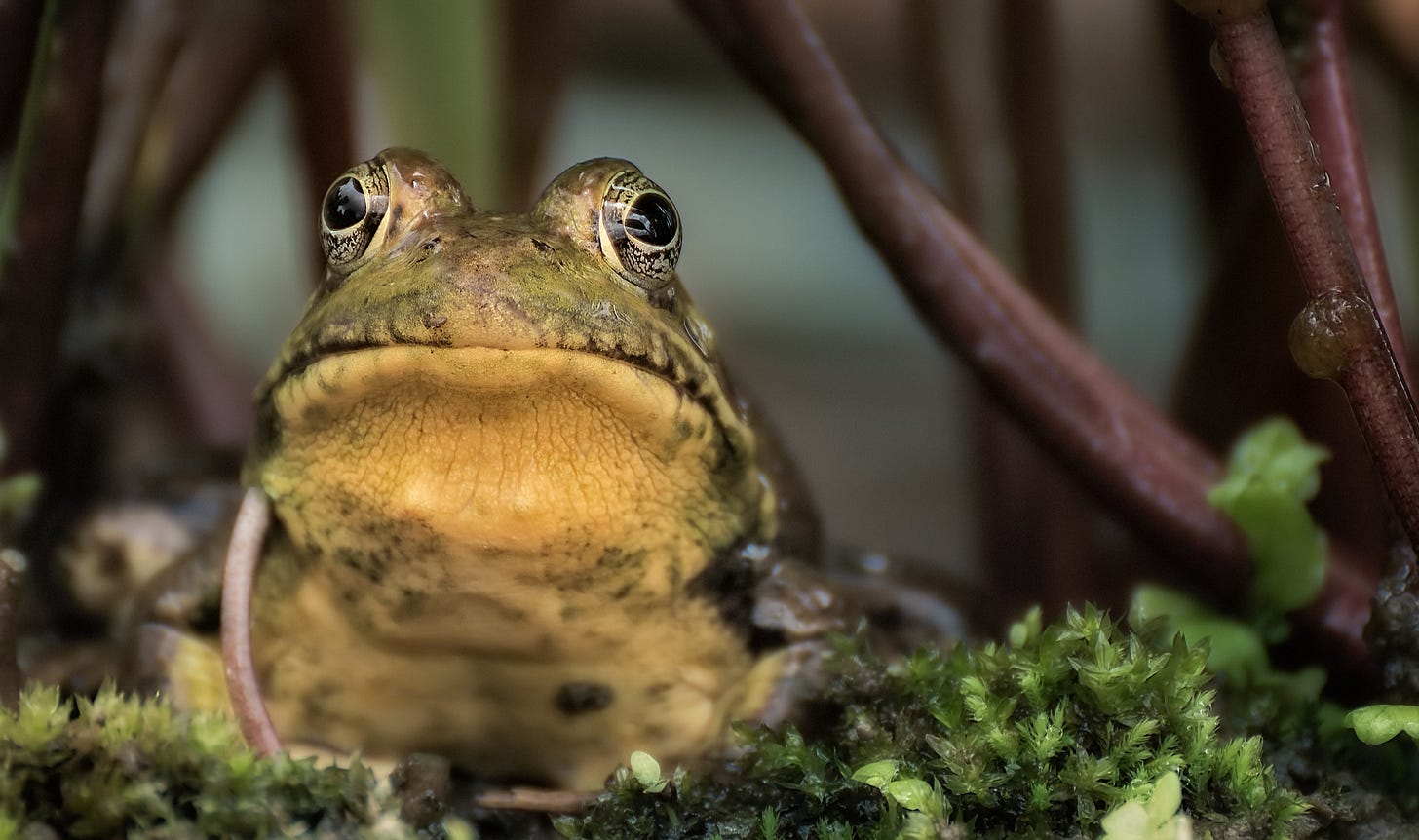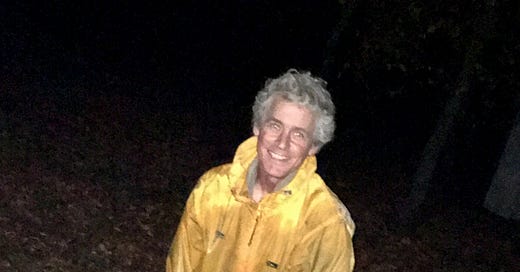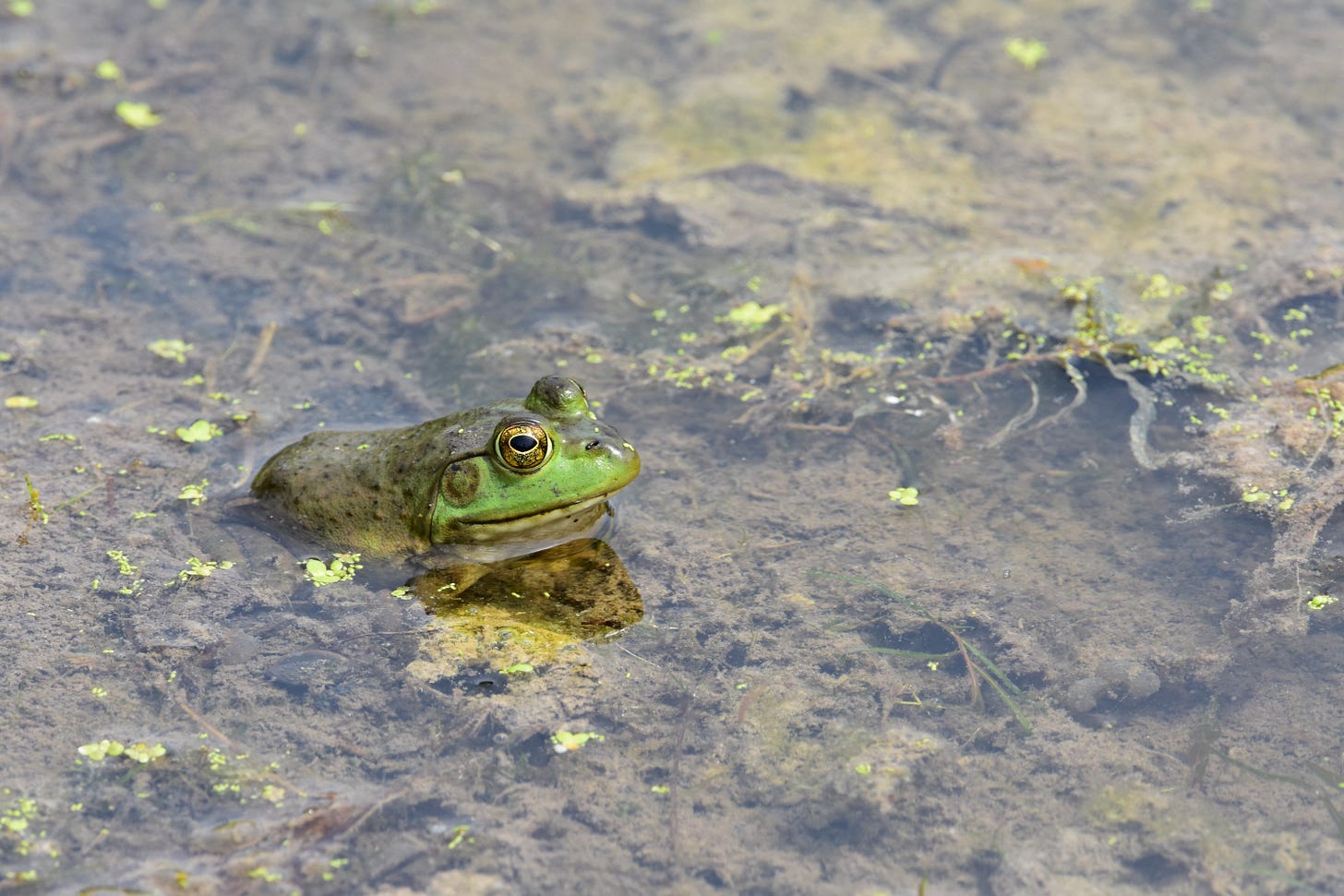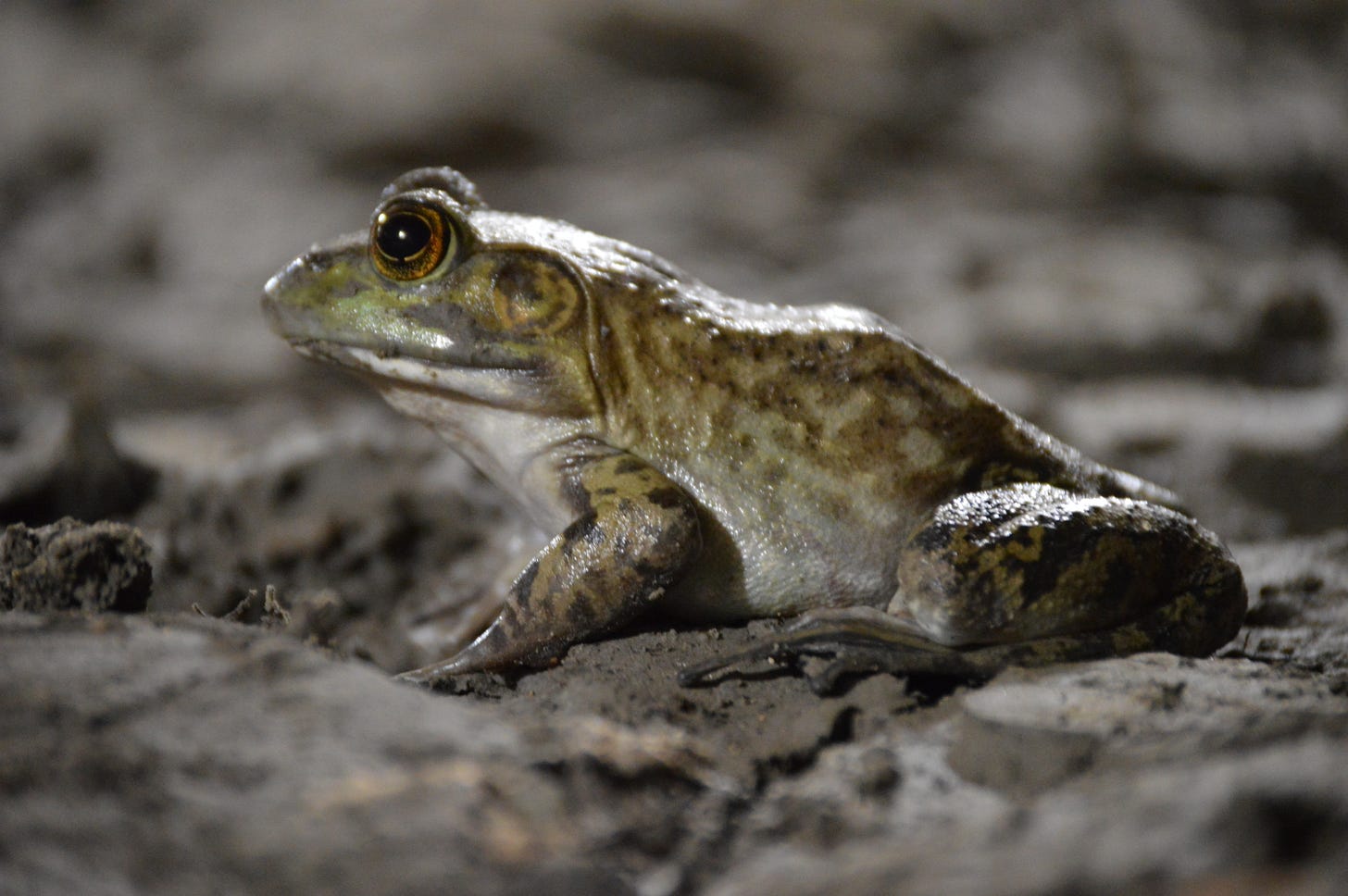Some summers ago, my industrious other half launched a crawl space renovation that had him under our house, hour after hour, on his hands and knees in the slick, heavy clay that is a hallmark of the soil in this part of the world. Though I am blessed with his good attitude, to say it was grueling work would not be an overstatement.
A bright point was the predictable presence of a bullfrog. Sometimes, she appeared to be watching from across the muck, like a golf spectator. Other times, she splooped into a soggy puddle, vanished for a day or three, then reappeared just like that. On occasion, I heard a voice drifting up through the drain pipes into the house and understood that my husband was having a little chat with his amphibious companion.
By late fall, drainage systems were working to de-swampify (a highly technical term) the space. Water that once ponded across the entire area was now shunted off into newly dug ditches wrapping the perimeter. The mission was suspended as winter moved in, but just ahead of ground freeze, the frog was captured - a remarkable feat unto itself given how nimble they are - and taken down the road to a marshy site where she could hibernate underwater.
Long before this project began, access to the crawl space was deliberately restricted, to keep our cats and other varmints out. We have no idea how our bulgy-eyed friend gained entrée in the first place, but we were proud of ourselves for releasing her from bondage.
Had she made such a house call on the other side of the country from us, or in many other places around the world, this frog would likely not have been greeted so warmly. And, that is a story that needs telling. I promise to get back to Kermit’s cousin shortly, but it’s important to situate her in the context of a larger environmental picture.
The American bullfrog is considered a highly invasive species in the western United States, Europe, South America and Asia. As with many creatures that now proliferate outside of their native ranges, bullfrogs were introduced to these areas accidentally-on-purpose. Some slipped in with fish stocking operations, some were discharged as a game species. (Frog legs anyone?) Over the years, they’ve been released by the unknowing and escaped from the unsuspecting. Now that they’re free, they’re going bonkers.
A single female bullfrog can lay up to 20,000 eggs at a time. Predators native to the eastern U.S., like large-mouth bass, blue heron, and snapping turtles, consume eggs, tadpoles, and adult frogs. Lacking this competition in other places, bullfrogs devastate their newfound habitats. They will eat anything they can fit in their mouths: birds, bats, reptiles, fish, insects, rodents, even each other. Unfortunately, nothing keeps their populations in check. And, on top of their reproductive vigor and their voracious appetites, they carry a fungus to which they are mostly immune but which further decimates other amphibians.
Nearly 20 years ago, in National Geographic, John Roach reported on the unstoppable surge in non-native bullfrogs around the world. More recently, Ted Williams blogged for the Nature Conservancy about the bullfrog plague, as well as ongoing efforts to control them. Neither writer offered evidence of any programs that are really getting a leg up on the frogs. There are just too many of them.
Counting aquatic and terrestrial plants, mammals, arthropods, amphibians and other organisms, the American bullfrog, known scientifically as Lithobates catesbeianus, is one of about 1500 total species categorized as invasive, foreign, non-native, or alien. As I thought about these labels and how many other things are stuck with them, I was struck by how similar they are to terms used to describe humans who move from one place to another. I also couldn’t help noticing the combative and nationalistic tone of the words and of those associated with their management. Verbs like “eradicate,” “eliminate,” “kill,” and “euthanize” show up with frequency in articles about forms of life that have moved beyond their original locations.
NOAA defines invasive species as animals or plants from another region of the world that don't belong in their new environment. But, what determines belonging, and who decides what does and does not? Has the line between the new environment and the original one always existed? Do we understand enough about how species migrate, breed, hybridize, and evolve across time to make such determinations? Most importantly, and especially because humans are directly or indirectly to blame for almost every redistribution, is there room for compassion in how we manage them?

It didn’t take long to discover others who have taken questions like mine to the next level, identifying biases and inconsistencies within the field of invasion biology and calling to attention the need for a more nuanced lens. Rather than searching for ways to rid our environment of non-native species, Nicholas Reo, who is an enrolled member of the Sault Ste. Marie Tribe of Chippewa Indians and an Assistant Professor of Environmental and Native American Studies at Dartmouth College, says, “It is our responsibility to figure out how they are useful.”
When I set out to tell the tale of a resident amphibian, it was not my original intention to leap into a much broader and more provocative exploration of our anthropocentric tendencies, but if I look at where I’ve landed from the frog’s perspective, it makes perfect sense. Indigenous principles teach us to see ourselves in kinship with all other beings. Frogs are members of our planetary family and, therefore, are deserving of the possibility of shifted thinking.
Our green playmate kept us company that whole summer, but once she’d been rehomed we didn’t think much more about her. We certainly never expected that when we opened up the crawl space the following spring we’d find another bullfrog hanging out in the damp darkness, looking ever so familiar. We’ll never know for sure if it was the same one, but it’s fun to believe she liked us so much that she returned. After all, bullfrogs can travel over a mile in damp environments.
We removed her a second time, all the while speculating about her solitary existence in that dank habitat. We decided she needed a she-shed, a place to get a break from the males whose noisy, nightly advertisement calls we hear undulating from the marshlands that surround us.
It’s been five years since we first made her acquaintance. We’ve not seen her again. But this winter, when the house was very quiet, we often heard soft, raspy sounds coming from somewhere just below the floor.
~Elizabeth
p.s. Find another 10 minutes to listen to more from Nicholas Reo here:







Wow Betsy. I learned so much about the bullfrog. We have many frogs in our yard and a few made it to my biology class🥲... and lots of sweet noises from the nearby lake are heard at night.... Don't think ours are bullfrogs but they are green.. And seem to be happy... Reminds me of some favorite lines in the past....
"When green is all there is to be
It could make you wonder why
But, why wonder, why wonder?
I'm green and it'll do fine
It's beautiful and I think it's what I want to be"
Loved this interesting story. Even as a card-carrying centrist I’m tempted to ask, tongue only somewhat in cheek, and with obvious exceptions, aren’t humans an invasive species?